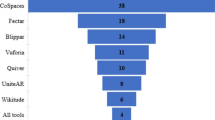Abstract
Augmented reality is an emerging technology that utilizes mobile, context-aware devices (e.g., smartphones, tablets) that enable participants to interact with digital information embedded within the physical environment. This overview of design principles focuses on specific strategies that instructional designers can use to develop AR learning experiences. A review of the literature reveals the following three design principles as instructive: 1. Enable and then challenge (challenge): 2. Drive by gamified story (fantasy); and 3. See the unseen (curiosity). These design principles can also be viewed as an attempt to either leverage the unique affor- dances of AR or minimize the limitations of the medium as reported in the literature (Dunleavy & Dede, 2014). As the field matures and more research teams explore the potential of AR to enhance teaching and learning, it will be critical to determine the design techniques that optimize the unique affordances of AR, minimize the limitations of the medium, and ultimately enhance learning across the curriculum.
Similar content being viewed by others
References
Azuma, R., Baillot, Y., Behringer, R., Feiner, S., Julier, S., & MacIntyre, B. (2001). Recent advances in augmented reality. IEEE Computer Graphics and Applications. 21 (6), 34–47. Computer Society Press Los Alamitos, CA, USA
Dede, C. (2009). Immersive interfaces for engagement and learning. Science 323(5910), 66–69. doi: 10.1126/science.1167311
Dunleavy, M., Dede, C., & Mitchell, R. (2009). Affordances and limitations of immersive participatory augmented reality simulations for teaching and learning. Journal of Science Education and Technology, 18 (1), 7–22
Dunleavy, M. (2010). Persistent Design Challenges: Augmenting Reality for Learning with Wireless Mobile Devices. Invitation Symposia at Society for Information Technology and Teacher Education (SITE). San Diego, CA.
Dunleavy, M. & Simmons, B. (2011). Assessing learning and identity in augmented reality science games. In L. Annetta & S. Bronack (Eds.), Serious educational games assessment (pp. 221–240). Rotterdam, The Netherlands: Sense Publishers.
Dunleavy, M. (2013). [Augmented reality design]. Unpublished raw data.
Dunleavy, M., & Dede, C. (2014). Augmented reality teaching and learning. In M.J. Bishop & J. Elen (Eds.), Handbook of Research on Educational Communications and Technology (4th ed., Volume 2), pp. 735–745. New York: Macmillan.
Facer, K., Joiner, R., Stanton, D., Reid, J., Hull, R., & Kirk, D. (2004). Savannah: mobile gaming and learning? Journal of Computer Assisted Learning, 20, 399–409.
Johnson, L., Smith, R., Willis, H., Levine, A., & Haywood, K., (2011). The 2011 Horizon Report. Austin, Texas: The New Media Consortium.
Kamarainen, A. M., Metcalf, S., Grotzer, T., Brown, A., Mazzuca, D., Tutwiler M.S. & Dede, C., (2013) Eco- MOBILE: Integrating augmented reality and probe- ware with environmental education field trips, Computers & Education.
Klopfer, E., Squire K. & Jenkins H. (2002). Environmental Detectives PDAs as a Window into a Virtual Simulated World. International Workshop on Wireless and Mobile Technologies in Education.
Klopfer, E. & Squire, K. (2008). Environmental Detectives - the development of an augmented reality platform for environmental simulations. Educational Technology Research and Development, 56 (2), 203–228.
Klopfer, E. & Sheldon, J. (2010), Augmenting your own reality: Student authoring of science-based augmented reality games. New Directions for Youth Development, 128 (Winter), 85–94.
Malone, T W (1981). Toward a theory of intrinsically motivating instruction.Cognitive science, 5(4), 333–369.
O’Shea, P, Mitchell, R., Johnston, C., & Dede, C. (2009). Lessons learned about designing augmented realities. International Journal of Gaming and Computer-Mediated Simulations. 1 (1), 1–15.
Palincsar, A. S. (1998). Social constructivist perspectives on teaching and learning. Annual Review of Psychology, 49, 345–375.
Perry, J., Klopfer, E., Norton, M., Sutch, D., Sandford, R., Facer, K. (2008). AR gone wild: two approaches to using augmented reality learning games in Zoos. Proceedings of the 8th international conference on International conference for the learning sciences, The Netherlands, 322–329.
Schell, J. (2008). The Art of Game Design: A book of lenses. Taylor & Francis US.
Spelman, H., & Hunnewell, J. F. (1872). Relation of Virginia. JF Hunnewell.
Squire, K. (2010). From Information to Experience: Place- Based Augmented Reality Games as a Model for Learning in a Globally Networked Society. Teachers College Record, 112 (10), pp. 2565–2602.
Squire, K.D., Jan, M., Matthews, J., Wagler, M., Martin, J., Devane, B. & Holden, C. (2007). Wherever you go, there you are: The design of local games for learning. In B. Sheldon & D. Wiley (Eds). The design and use of simulation computer games in education, (pp. 265–296). Rotterdam, Netherlands: Sense Publishing.
Woodard, Buck. (2005). Appendix A: Natives in the landscape: Images and documents of seventeenth century Virginia Indians in A Study of Virginia Indians and Jamestown: The First Century. Prepared for the Colonial National Historical Park. National Park Service: Williamsburg.
Author information
Authors and Affiliations
Rights and permissions
About this article
Cite this article
Dunleavy, M. Design Principles for Augmented Reality Learning. TECHTRENDS TECH TRENDS 58, 28–34 (2014). https://doi.org/10.1007/s11528-013-0717-2
Published:
Issue Date:
DOI: https://doi.org/10.1007/s11528-013-0717-2




